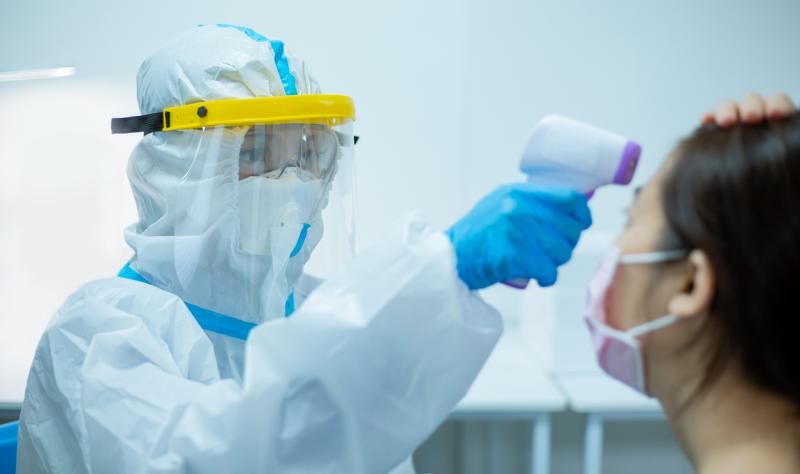Scientists see few signs of a big COVID-19 wave this winter. But you just never know.


In his darker moments, Dr. Jeremy Luban wonders: Could it happen again? Could a radically new version of COVID-19 suddenly emerge?
The situation this fall is “eerily” similar to a year ago, said Luban, professor of molecular medicine, biochemistry, and molecular biotechnology at the UMass Chan Medical School. Back then, the Delta variant carried the day, just as Omicron subvariants dominate today. Then as now, no one expected a big change.
But instead of a smooth Delta winter, the world woke up last Thanksgiving morning to find a new monster among us, the ultra-transmissible Omicron. With more than 50 new mutations, some of which enabled the virus to evade immunity, the variant immediately barreled across the globe.
Could a new and scary version of COVID-19 suddenly appear again this year, spewing a new wave of infections?
In his optimistic moments, Luban realizes there’s no reason to think so. “We haven’t seen the signs of an enormous new wave yet,” he said.
Yet.
SARS-Cov-2, the virus that causes COVID-19, has been with us for less than three years, and its long-term patterns have yet to be revealed, said Cécile Viboud, an epidemiologist at the Fogarty International Center at the National Institutes of Health. Will an evolutionary leap like Omicron occur once every three years? Once a decade?
Or next month?
“Right now, we don’t have any signs that this will happen,” Viboud said. But the possibility can’t be excluded. “We shouldn’t let our guard down,” she said.
Even so, Viboud said, “Because of the high level of immunity in the population, we’re not going to see an epidemic the same size as what we saw last winter.”
Meanwhile, Omicron is spawning different versions of itself, each a little better at sneaking past antibodies, the body’s first line of defense. That means people who’ve been vaccinated or infected can still come down with COVID-19, and as people gather indoors without masks through the fall and winter, more are likely to get sick.
Even so, throughout the Omicron wave, the deeper levels of immunity that protect against severe illness have held strong.
“Through all this past year, with all the different Omicron variants and the high rates of infection, we haven’t seen anything that greatly increases the rate of hospitalization or death,” Luban said. “As long as someone has been vaccinated, they do OK. …
“You can get pretty sick with Omicron. But you’re far less likely to get sick enough to require hospitalization. There’s no indication that I’ve seen that protection is going away. That’s huge.”
Still, rampant COVID-19 infections, even if they don’t kill, can do great harm. “There’s huge economic costs if you can’t work for a week,” Luban noted, especially at a time when virtually every industry, from airlines to coffee shops, faces staff shortages.
The new booster shot, which protects against the original strain as well as Omicron variants, may lower the risk of infection, and appears likely to work well at preventing severe illness caused by any variant, Luban said. Yet many people eligible for the vaccine have so far not taken it.
Because immunity wanes over time, the booster shot is considered critical in blunting the expected rise in infections during winter. A recent Commonwealth Fund study estimated that 75,000 lives could be saved, and 745,000 hospitalizations prevented, if a fall booster campaign reaches as many people as took the flu vaccine in the 2020-21 season.
In Massachusetts and throughout the nation, the Omicron subvariant called BA.5 remains the dominant strain, although it is slowly losing ground to BA.4.6, a subvariant that is similar enough that it isn’t raising alarms.
The Broad Institute of MIT and Harvard has been testing about 50,000 samples a week, most from schools, colleges, or care homes in Massachusetts. The institute sequences about 10 percent of those, said Bronwyn MacInnis, the Broad’s director of pathogen genomic surveillance.
In Massachusetts last week, BA.5 accounted for about 70 percent of infections but was trending downward, MacInnis said; BA.4.6 is currently at 20 percent and growing.
The remaining 10 percent, MacInnis said, is a mixture of other variants. Fewer than 10 cases of BA.2.75.2, prevalent in India, have been detected in Massachusetts.
“We’re keeping our eye out for BA.2.75.2,” MacInnis said. “It is highly transmissible and seems to be able to evade monoclonal antibody therapies. We’re still waiting to see how it will do with the new Omicron bivalent vaccine.”
But so far this variant has made little headway outside of India, casting doubt on its ability to supplant the dominant Omicron subvariant.
In a change from previous patterns, she noted, different variants are bubbling up in different regions, with none rising to the top everywhere.
Although new variants are not to blame, COVID-19 hospitalizations have started to tick up in Massachusetts, reaching a seven-day average of 724 people as of Tuesday. Still, that’s just 23 percent of the number hospitalized during January’s peak, although more than were seen last year at this time.
The amount of coronavirus found in waste water, a helpful preview of the pandemic’s trajectory, rose steeply in the end of September. It has since declined a little. MacInnis said she wasn’t alarmed by the wastewater data, because there hasn’t been a similar spike in hospital admissions.
“There’s no reason to be particularly worried about fall and winter. We will see an uptick but hopefully not a tidal wave,” she said. “We’ve reached a more stable equilibrium. We haven’t had another variant that isn’t an Omicron descendant emerge for close to a year. It may be that we are reaching a state where we are moving past the point of major spikes like we saw last year.
“Of course,” she added, “it depends on what additional tricks the virus has up its sleeve.”
The big worry this year may turn out to be the flu. There may be lowered immunity in the population because COVID-19 precautions prevented flu infections in the previous two winters, Viboud said. This year, many people have abandoned safety measures such as masking, and as indoor gatherings and holiday events begin, transmission of both COVID-19 and the flu could soar.
“Two nasty respiratory viruses combined might be a threat,” Viboud said.
Felice J. Freyer can be reached at felice.freyer@globe.com. Follow her on Twitter @felicejfreyer.



